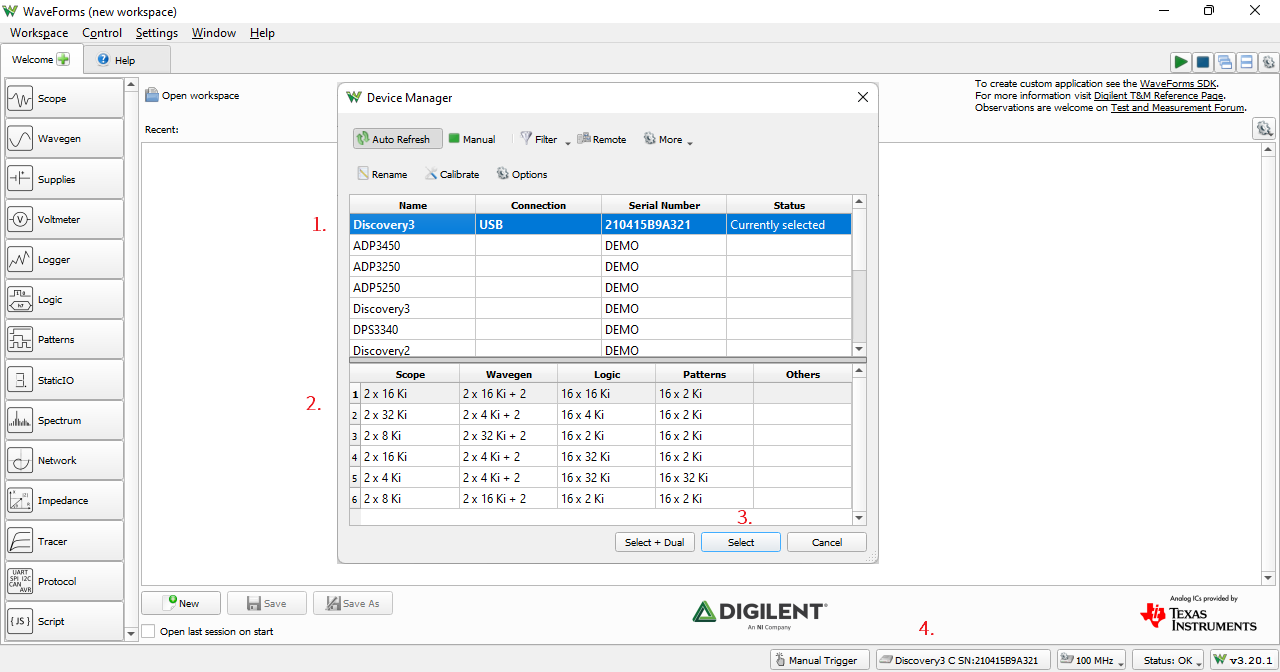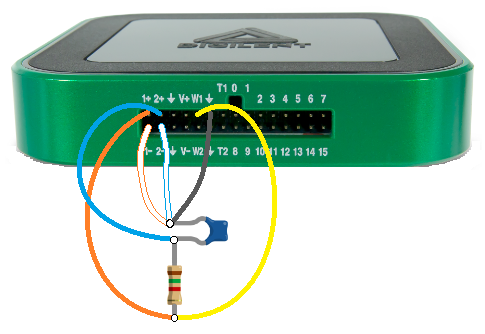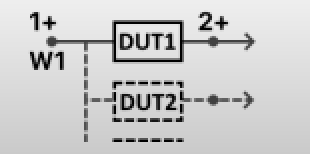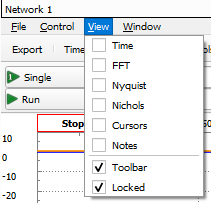Using the Network Analyzer
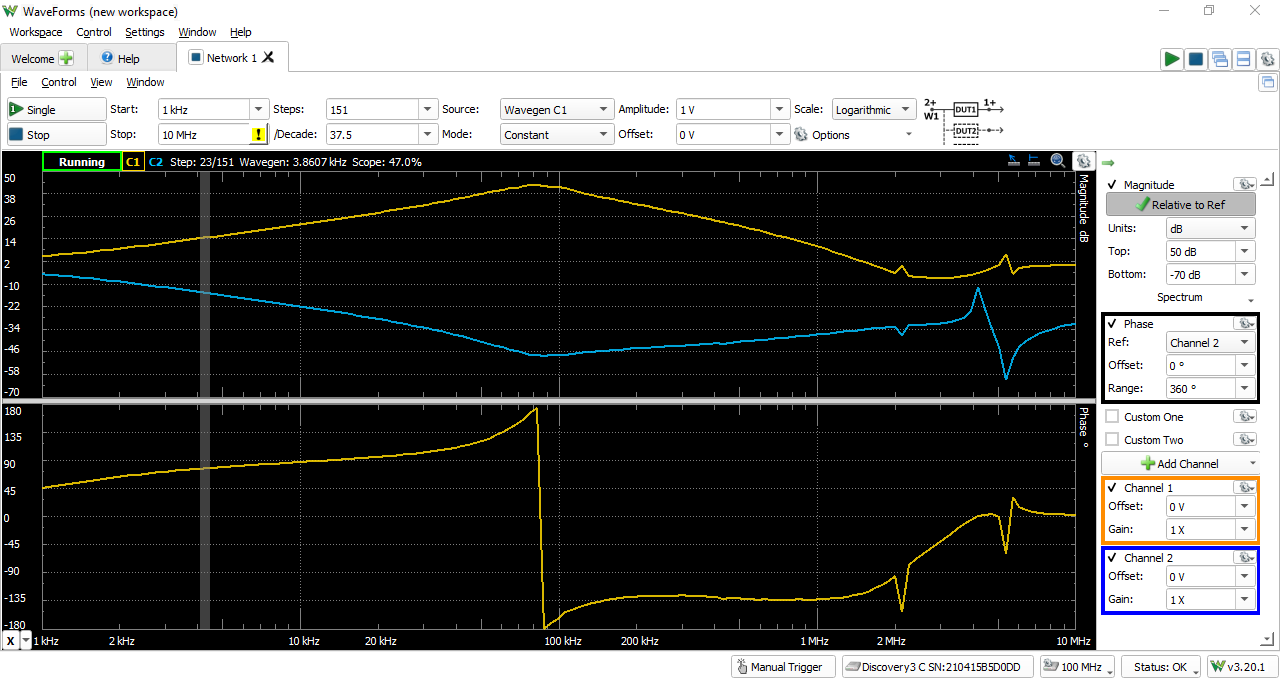
Introduction
Network Analyzers are used to measure the frequency response of a circuit-under-test. This guide explains the use of WaveForms' Network Analyzer instrument. This instrument is also referred to as Network within WaveForms.
Prerequisites
- A Digilent Test & Measurement Device with Analog Input and Output Channels:
- A Computer with WaveForms Software Installed
- 1.5 kΩ resistor - optional, for testing
- 10 nF capacitor - optional, for testing
Guide
1. Opening the Network Analyzer
1.1
Plug in the Test & Measurement Device, then start WaveForms and make sure the device is connected.
If no device is connected to the host computer when WaveForms launches, the Device Manager will be launched. Make sure that the device is plugged in and turned on, at which point it will appear in the Device Manager's device list (1). Click on the device in the list to select it, then click on the buffer size (2). Click the Select button (3) to close the Device Manager.
Note: “DEMO” devices are also listed, which allow the user to use WaveForms and create projects without a physical device.
Note: The Device Manager can be opened by clicking on the “Connected Device” button in the bottom right corner of the screen (4.), or by selecting “Device Manager” from the “Settings” menu at the top of the screen.
1.2
Once the Welcome page loads, in the instrument panel at the left side of the window, click on the Network button to open the Network Analyzer instrument.
1.3
Once the Network Analyzer instrument opens, the window contains the plot plane split horizontally into two subplot planes, the control bar above the plot planes, and the configuration panel to the right of the plot plane.
2. Using the Network Analyzer
This section walks through setting up the Network Analyzer to plot the frequency response of a low-pass filter.
2.1 Hardware Setup
Connect the Test & Measurement device's Oscilloscope channel 1 pin and the device's Wavegen channel 1 to the 1.5 kΩ resistor. Connect the Oscilloscope Channel 2 and the capacitor to the other pin of the resistor. Connect the Wavegen channel's ground to the floating pin of the capacitor.
When using a device with MTE cables, such as the Analog Discovery 3 for analog inputs and outputs, Wavegen channel 1 is a yellow wire and Oscilloscope channel 1 is an orange wire on the MTE cable.
For devices that use differential input channels, with MTE cables, make sure to connect the Oscilloscope channel 1 negative and channel 2 negative pins (orange wire with white stripes and blue wire with white stripes, respectively) to the ground pin associated with Wavegen channel 1 (black wire).
2.2 Run the Network Analyzer
By default, the Network Analyzer uses the Test & Measurement Device's Wavegen channel 1 as the source signal and does not need any further configuration from the Wavegen instrument window. From the control bar, click Run to continuously sweep the circuit network with an input signal of varying frequency - by default, the frequency sweep ranges from 1 kHz to 1 MHz.
While sweeping, the Run button ( ) changes to Stop (
) changes to Stop ( ). Click Stop to stop outputting analog voltages, and to stop capturing data on the analog input pins. Click Single (
). Click Stop to stop outputting analog voltages, and to stop capturing data on the analog input pins. Click Single ( ) to sweep the circuit network only once.
) to sweep the circuit network only once.
With the Wavegen connected to the scope channel 1 input, the plot panes should show channel 1 (orange trace) as a flat 0db magnitude plot, channel 2 (blue trace) magnitude plot decreasing from 0dB to -40dB (this is the magnitude of the filter's frequency response). With the phase reference set to channel 1, the phase of channel 2 is correspondingly shown to decrease from 0 degrees to -90 degrees.
When using a device with more than two channels, these channels are also present in the plot panes and have their own configuration options.
When using a device with BNC cables, make sure to set the attenuation of the oscilloscope probes in the channel options ( ).
).
2.3 Plot Pane Axes
By default, the top pane displays the magnitude response of the circuit network in decibels (from +10dB to -90dB) and the bottom pane displays the phase response of the circuit network in degrees (from +180° to -180°). These respective values are on the left side vertical axis and are adjusted using the configuration panel.
The bottom axis is shared by both plots and by default displays every frequency in the sweep range (1 kHz to 1 MHz). The range can be adjusted using the Control Bar. Alternately, the range can be changed by hovering a mouse over an axis or plot pane and scrolling the mouse wheel.
2.4 Data Cursors
To take a quick measurement of the plotted magnitude and phase at a given frequency, click the Quick Measure: Vertical button ( ), located at the top right corner of the top plot pane. Move the cursor over the plot pane and observe the values displayed. Click once to set that cursor, click a second time to place a second delta cursor. A third click or clicking the Quick Measure: Vertical button again will remove these cursors.
), located at the top right corner of the top plot pane. Move the cursor over the plot pane and observe the values displayed. Click once to set that cursor, click a second time to place a second delta cursor. A third click or clicking the Quick Measure: Vertical button again will remove these cursors.
To place one or more normal or delta cursors, click the Add Cursor button in the bottom left pane. The first click will generate a normal cursor and repeated clicks will generate additional delta cursors referenced to the first cursor. To change the delta cursors to a normal cursor, click the arrow icon on that cursor's button on the bottom of the pane plot and change reference to “none”. Additionally, selecting “Remove” will delete the cursor from the plot pane.
Note: Using Multiple Instruments
The Network Analyzer instrument can be used with other WaveForms instruments. Using multiple instruments at the same time is helpful in a wide variety of situations. One example would be to use the the Power Supplies to provide power to the Network Analyzer's circuit under test. More information on how instruments can be operated together can be found in the Using Cross Triggering guide.
It should be noted that the Analog Input channels cannot be shared by multiple instruments. When the Network Analyzer is enabled, any other instruments using the Analog Input channels are disabled. Other instruments that use the Analog Input channels include the Oscilloscope, Voltmeter, Data Logger, Spectrum Analyzer, and Impedance Analyzer. The same is true for the Analog Output channels, which are shared by the Waveform Generator and Impedance Analyzer.
3. Network Analyzer User Interface Overview
This section walks through the wide variety of controls and features present in the Network Analyzer instrument.
3.1 Control Bar
The Control Bar can be found above the plot pane. The control bar contains the Single and Run acquisition buttons, as well as several settings that control the frequency sweep used to probe the circuit under test, accessible via either drop-down menus or text fields.
Additionally, a diagram of the suggested setup surrounding your circuit or device under test can be seen on the right side of the control bar.
- Start: Allows you to set the frequency that the sweep starts at. The range is 20 μHz to one-quarter of the System Clock frequency - 25 MHz by default for most devices. A yellow warning icon will appear when the selected frequency is outside of the device's Waveform Generator bandwidth (or the Oscilloscope bandwidth when using an external wavegen source).
- Stop: Allows you to set the frequency that the sweep stops at. The range is 20 μHz to one-quarter of the System Clock frequency - 25 MHz by default for most devices. A yellow warning icon will appear when the selected frequency is outside of the device's Waveform Generator bandwidth (or the Oscilloscope bandwidth when using an external wavegen source).
- Steps: Controls how many samples are captured during a sweep. Defines the change in frequency between each sample. (Only applicable for Linear scale)
- /Decade: “Samples per Decade”, controls how many samples are captured during a sweep. A “decade” represents a factor of ten between two frequencies. For example, if a sweep starts at 10 kHz, and /Decade is set to 20, 20 samples will be captured
- Source: Set the source of the waveform generation. Options are External, Wavegen C1, Wavegen C2, or Differential.
- Mode: Drop-down menu to enable/disable amplitude sweep (Constant – only frequency sweep mode, or Table – frequency and amplitude sweep) or to define a custom excitation with JavaScript syntax
- Amplitude: Set the voltage amplitude for the signal. The range is 10 mV to 5V.
- Offset: Add a DC offset to the amplitude of the signal. The range is -5 V to +5 V.
- Scale: Logarithmic or Linear, defines the frequency scale used on the plot, as well as the method used to determine frequencies to be measured.
- Options: Presents several additional less-commonly-used options, including the ability to adjust the Amplification, Settle time, Minimum number of periods, Average, Averaging, and number of Samples taken per frequency step.
These settings can also be changed by clicking and dragging the plot or by using the mouse wheel - “panning” and “zooming” the plot.
3.2 Configuration Panel
The first side panel control block is the Magnitude plot configuration window. By default, the units are decibels with a ceiling of 10dB and a floor of -90dB. These parameters can be changed by selecting the drop-down menus labeled Units, Top, and Bottom, respectively.
Below the Magnitude plot configuration window is the Phase plot configuration window. Here you can select a channel to use as the phase reference (by default it is the first analog input channel). By default, the Offset and Range are set to 0 degrees and 360 degrees, respectively. To change these values, click the Offset and Range drop-down menus, respectively.
Below the Phase plot configuration window are two Custom measurement windows. By default, these windows are deselected. To add a custom measurement, click the selection box on the left side of the custom window name and that window will be added to the plot plane. To change the scale, units, and name for the window, click Gear icon ( ) and update the Scale, Units, and Name fields. To change the range of the plot, click on or type into the Top and Bottom fields. Click the bottom button to change or program a custom measurement. By default, Custom channel 1 is set to measure a Real value and Custom channel 2 is set to measure an Imaginary value.
) and update the Scale, Units, and Name fields. To change the range of the plot, click on or type into the Top and Bottom fields. Click the bottom button to change or program a custom measurement. By default, Custom channel 1 is set to measure a Real value and Custom channel 2 is set to measure an Imaginary value.
Below the Custom window buttons is the Add Channel button ( ). Click this button to add a new channel to the plot, including reference channels, which can be used to compare saved data to the capture.
). Click this button to add a new channel to the plot, including reference channels, which can be used to compare saved data to the capture.
Below the Custom/Add channel buttons are the channel configuration windows. By default, the Offset and Gain parameters are set to 0 volts and 1x, respectively. To change these values click on or type in the Offset or Gain fields, respectively.
3.3 Plot Pane
The plot pane displays data captured on the analog input channels during the stimulus sweep. The horizontal axis of the plot represents the sample frequency. The vertical axis in the top plot represents the gain of the circuit. The vertical axis in the bottom plot represents the phase shift imposed on the test signal by the circuit under test.
A status indicator in the top left corner of the plot pane displays whether the Network Analyzer is running (“Stop”/“Running”). While a sweep is underway, the progress is shown. While stopped, information about the sweep being displayed is shown, including sample count, frequency range, and a timestamp.
3.3.1 Plot - Utilities
The Utility button ( ) in the top right corner of the plot pane can be used to add labels to the plot, change the background color and line width, as well as set the default quick-measure tool.
) in the top right corner of the plot pane can be used to add labels to the plot, change the background color and line width, as well as set the default quick-measure tool.

3.3.2 Plot - Quick Measure Tools
Another set of buttons can be found in the upper right corner of the plot pane:
- Free (
 ) measures the difference between two mouse clicks, expressed in magnitude (or phase) and frequency.
) measures the difference between two mouse clicks, expressed in magnitude (or phase) and frequency. - Vertical (
 ) is similar to Free mode but measures differences between two vertical lines, rather than two points. It can be used to display both phase and magnitude differences at once.
) is similar to Free mode but measures differences between two vertical lines, rather than two points. It can be used to display both phase and magnitude differences at once. - Show Entire Capture (
 ) resets any pans or zooms made on the plot, displaying the entire sweep.
) resets any pans or zooms made on the plot, displaying the entire sweep.
3.4 File Menu
The File menu at the top of the window contains operations that affect the filesystem of the host computer.
Saving a project (with or without any acquisitions) allows the user to close WaveForms without losing any configurations. In addition to this, projects can be shared with others to aid in group projects and guided learning.
Exporting data as an image allows the user to produce a screenshot of the entire Scope tool. Alternatively, captured data can be exported in a variety of different file formats, including CSV, TXT, and TDMS.
3.5 Control Menu
The Control menu at the top of the window provides the same functionality as the Single/Stop/Run buttons, and lists hotkeys that can be used for each.
3.6 View Menu
A wide variety of different view panes can be added to the user interface using the View menu in the toolbar above the Single/Run/Stop buttons. Each pane, once opened, can be closed by clicking the “X” button in the top right corner of its pane. A description of each view in the menu is listed below:
- Time: Displays the signal captured on the analog input channels, in the time domain.
- FFT: Displays a Fast-Fourier Transform breakdown of the sweep.
- Nyquist: Displays a Nyquist plot of the sweep.
- Nichols: Displays a Nichols plot of the sweep.
- Cursors: Lists each “X” cursor added to the plot.
- Notes: A text editor pane that can be used to document configuration choices, or whatever other information could be useful to remember.
- Toolbar: Displays the View menu options in a toolbar.
- Locked: Enables/disables docking of the Toolbar.
Next Steps
For more guides on how to use the Digilent Test and Measurement Device, return to the device's Resource Center, linked from the Test and Measurement page of this wiki.
For more information on WaveForms visit the WaveForms Reference Manual.
For technical support, please visit the Test and Measurement section of the Digilent Forums.

